| Left atrial enlargement | |
|---|---|
| Other names | Left atrial dilation |
 | |
| Specialty | Cardiology |
Left atrial enlargement (LAE) or left atrial dilation refers to enlargement of the left atrium (LA) of the heart, and is a form of cardiomegaly.
| Left atrial enlargement | |
|---|---|
| Other names | Left atrial dilation |
 | |
| Specialty | Cardiology |
Left atrial enlargement (LAE) or left atrial dilation refers to enlargement of the left atrium (LA) of the heart, and is a form of cardiomegaly.
Left atrial enlargement can be mild, moderate or severe depending on the extent of the underlying condition. Although other factors may contribute, left atrium size has been found to be a predictor of mortality due to both cardiovascular issues as well as all-cause mortality. Research suggests that left atrium size as measured by an echo-cardiograph may be linked to cardiovascular disease. However, studies that have found LAE to be a predictor for mortality recognize the need for more standardized left atrium measurements than those found in an echo-cardiogram. [1]
In the general population, obesity appears to be the most important risk factor for LAE. [2] LAE has been found to be correlated to body size, independent of obesity, meaning that LAE is more common in people with a naturally large body size. [1] Also, a study found that LAE can occur as a consequence of atrial fibrillation (AF), [3] although another study found that AF by itself does not cause LAE. The latter study also showed that the persistent type of AF was associated with LAE, but the number of years that a subject had AF was not. [4]
Obstructive sleep apnea (OSA) may be a cause of LAE in some cases. When an OSA event occurs, an attempt is made to breathe with an obstructed airway and the pressure inside the chest is suddenly lowered. The negative intrathoracic pressure may cause the left atrium to expand and stretch its walls during each OSA event. Over time, the repetitive stretching of the left atrium may result in a persistent left atrial enlargement. [5]

LAE is suggested by an electrocardiogram (ECG) that has a pronounced notch in the P wave. [7] However, if atrial fibrillation is present, a P wave would not be present. [8] In any case, LAE can be diagnosed and measured using an echocardiogram (ECHO) by measuring the left atrial volume (LAVI).
Characterizing the size of the left atrium according to its volume is preferred over a single linear dimension since enlargement can be different for different directions. For example, because of the smaller distance in the thoracic cavity between the sternum and spine, compared to the other directions, less room exists for enlargement of the left atrium along the anteroposterior axis. [9] By approximating the shape of the left atrium as an ellipsoid, its volume can be calculated from measurements of its dimensions along three perpendicular directions. [3]
Indexing the left atrial volume to body surface area (volume/BSA) is recommended by the American Society of Echocardiography and the European Association of Echocardiography. The values for volume/BSA in the following table are the best validated, and are the same for both men and women. [9]

Cardiology is a branch of medicine that deals with disorders of the heart and the cardiovascular system. The field includes medical diagnosis and treatment of congenital heart defects, coronary artery disease, heart failure, valvular heart disease and electrophysiology. Physicians who specialize in this field of medicine are called cardiologists, a specialty of internal medicine. Pediatric cardiologists are pediatricians who specialize in cardiology. Physicians who specialize in cardiac surgery are called cardiothoracic surgeons or cardiac surgeons, a specialty of general surgery.

The mitral valve, also known as the bicuspid valve or left atrioventricular valve, is one of the four heart valves. It has two cusps or flaps and lies between the left atrium and the left ventricle of the heart. The heart valves are all one-way valves allowing blood flow in just one direction. The mitral valve and the tricuspid valve are known as the atrioventricular valves because they lie between the atria and the ventricles.
An ejection fraction (EF) is the volumetric fraction of fluid ejected from a chamber with each contraction. Thus understood, ejection fraction may be used to measure a fluid of any viscosity discharged from a hollow organ to another cavity or outside of the body. Blood, bile and urine are commonly studied under this mathematical platform. For example, it may refer to the cardiac atrium, ventricle, gall bladder, or leg veins, although if unspecified it usually refers to the left ventricle of the heart. EF is widely used as a measure of the pumping efficiency of the heart and is used to classify heart failure types. It is also used as an indicator of the severity of heart failure, although it has recognized limitations.

Atrial flutter (AFL) is a common abnormal heart rhythm that starts in the atrial chambers of the heart. When it first occurs, it is usually associated with a fast heart rate and is classified as a type of supraventricular tachycardia. Atrial flutter is characterized by a sudden-onset (usually) regular abnormal heart rhythm on an electrocardiogram (ECG) in which the heart rate is fast. Symptoms may include a feeling of the heart beating too fast, too hard, or skipping beats, chest discomfort, difficulty breathing, a feeling as if one's stomach has dropped, a feeling of being light-headed, or loss of consciousness.

Mitral stenosis is a valvular heart disease characterized by the narrowing of the opening of the mitral valve of the heart. It is almost always caused by rheumatic valvular heart disease. Normally, the mitral valve is about 5 cm2 during diastole. Any decrease in area below 2 cm2 causes mitral stenosis. Early diagnosis of mitral stenosis in pregnancy is very important as the heart cannot tolerate increased cardiac output demand as in the case of exercise and pregnancy. Atrial fibrillation is a common complication of resulting left atrial enlargement, which can lead to systemic thromboembolic complications like stroke.
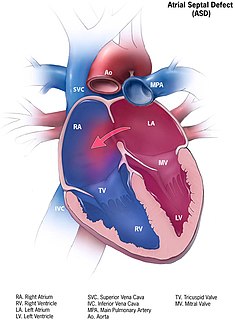
Atrial septal defect (ASD) is a congenital heart defect in which blood flows between the atria of the heart. Some flow is a normal condition both pre-birth and immediately post-birth via the foramen ovale; however, when this does not naturally close after birth it is referred to as a patent (open) foramen ovale (PFO). It is common in patients with a congenital atrial septal aneurysm (ASA).
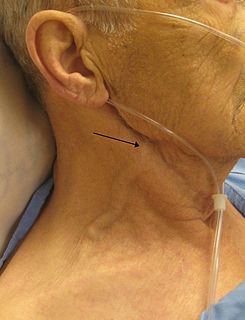
The jugular venous pressure is the indirectly observed pressure over the venous system via visualization of the internal jugular vein. It can be useful in the differentiation of different forms of heart and lung disease. Classically three upward deflections and two downward deflections have been described.
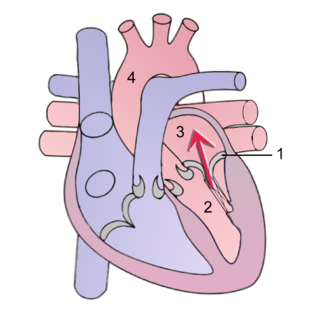
Mitral regurgitation(MR), also known as mitral insufficiency or mitral incompetence, is a form of valvular heart disease in which the mitral valve is insufficient and does not close properly when the heart pumps out blood. It is the abnormal leaking of blood backwards – regurgitation from the left ventricle, through the mitral valve, into the left atrium, when the left ventricle contracts. Mitral regurgitation is the most common form of valvular heart disease.
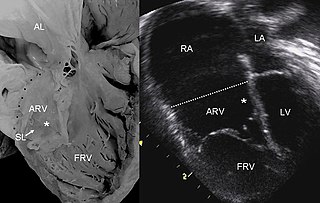
Ebstein's anomaly is a congenital heart defect in which the septal and posterior leaflets of the tricuspid valve are displaced towards the apex of the right ventricle of the heart. It is classified as a critical congenital heart defect accounting for <1% of all congenital heart defects presenting in ≈1 per 200,000 live births. Ebstein anomaly is the congenital heart lesion most commonly associated with supraventricular tachycardia.

The atrium is one of two upper chambers in the heart that receives blood from the circulatory system. The blood in the atria is pumped into the heart ventricles through the atrioventricular valves.
A transthoracic echocardiogram (TTE) is the most common type of echocardiogram, which is a still or moving image of the internal parts of the heart using ultrasound. In this case, the probe is placed on the chest or abdomen of the subject to get various views of the heart. It is used as a non-invasive assessment of the overall health of the heart, including a patient's heart valves and degree of heart muscle contraction. The images are displayed on a monitor for real-time viewing and then recorded.

Valvular heart disease is any cardiovascular disease process involving one or more of the four valves of the heart. These conditions occur largely as a consequence of aging, but may also be the result of congenital (inborn) abnormalities or specific disease or physiologic processes including rheumatic heart disease and pregnancy.

Atrial fibrillation is an abnormal heart rhythm (arrhythmia) characterized by rapid and irregular beating of the atrial chambers of the heart. It often begins as short periods of abnormal beating, which become longer or continuous over time. It may also start as other forms of arrhythmia such as atrial flutter that then transform into AF. Episodes can be asymptomatic. Symptomatic episodes may involve heart palpitations, fainting, lightheadedness, shortness of breath, or chest pain. Atrial fibrillation is associated with an increased risk of heart failure, dementia, and stroke. It is a type of supraventricular tachycardia.

Left atrial appendage occlusion (LAAO), also referred to as left atrial appendage closure (LAAC), is a treatment strategy to reduce the risk of left atrial appendage blood clots from entering the bloodstream and causing a stroke in patients with non-valvular atrial fibrillation (AF).

The P wave on the ECG represents atrial depolarization, which results in atrial contraction, or atrial systole.
The management of atrial fibrillation (AF) is focused on preventing temporary circulatory instability, stroke and other ischemic events. Control of heart rate and rhythm are principally used to achieve the former, while anticoagulation may be employed to decrease the risk of stroke. Within the context of stroke, the discipline may be referred to as stroke prevention in atrial fibrillation (SPAF). In emergencies, when circulatory collapse is imminent due to uncontrolled rapid heart rate, immediate cardioversion may be indicated.

Arrhythmias, also known as cardiac arrhythmias, heart arrhythmias, or dysrhythmias, are irregularities in the heartbeat, including when it is too fast or too slow. A resting heart rate that is too fast – above 100 beats per minute in adults – is called tachycardia, and a resting heart rate that is too slow – below 60 beats per minute – is called bradycardia. Some types of arrhythmias have no symptoms. Symptoms, when present, may include palpitations or feeling a pause between heartbeats. In more serious cases, there may be lightheadedness, passing out, shortness of breath or chest pain. While most cases of arrhythmia are not serious, some predispose a person to complications such as stroke or heart failure. Others may result in sudden death.
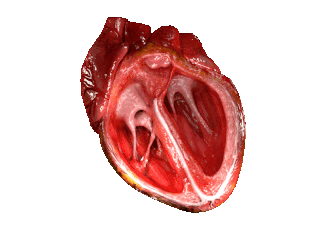
Heart failure with preserved ejection fraction (HFpEF) is a form of heart failure in which the ejection fraction – the percentage of the volume of blood ejected from the left ventricle with each heartbeat divided by the volume of blood when the left ventricle is maximally filled – is normal, defined as greater than 50%; this may be measured by echocardiography or cardiac catheterization. Approximately half of people with heart failure have preserved ejection fraction, while the other half have a reduction in ejection fraction, called heart failure with reduced ejection fraction (HFrEF).
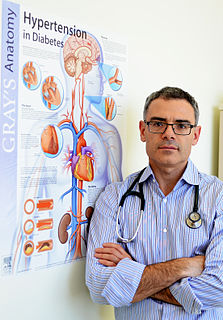
Yaariv Khaykin is a Canadian cardiologist and a clinical researcher in the area of electrophysiology. He is the director of the Newmarket Electrophysiology Research Group at the Southlake Regional Health Centre. He has published research into complex ablation and pioneered cardiac ablation methods.
The volume of the heart's left atrium is an important biomarker for cardiovascular physiology and clinical cardiology. It is usually calculated as left atrial volume index in terms of body surface area.